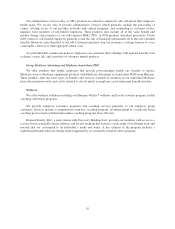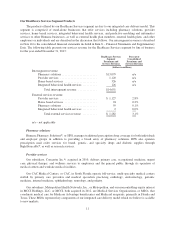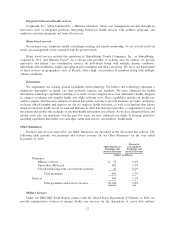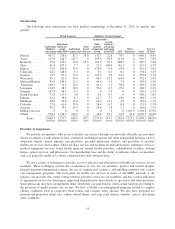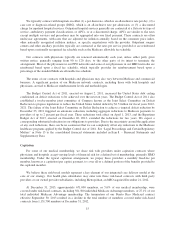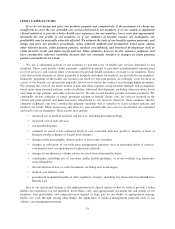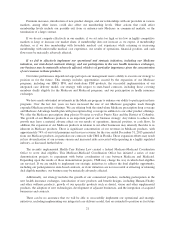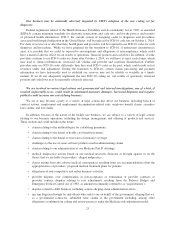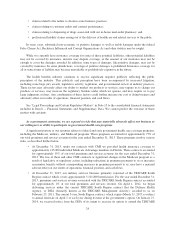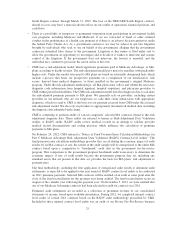Humana 2013 Annual Report Download - page 30
Download and view the complete annual report
Please find page 30 of the 2013 Humana annual report below. You can navigate through the pages in the report by either clicking on the pages listed below, or by using the keyword search tool below to find specific information within the annual report.In addition, we also estimate costs associated with long-duration insurance policies including long-term
care, life insurance, annuities, and certain health and other supplemental insurance policies sold to individuals for
which some of the premium received in the earlier years is intended to pay anticipated benefits to be incurred in
future years. At policy issuance, these future policy benefit reserves are recognized on a net level premium
method based on interest rates, mortality, morbidity, and maintenance expense assumptions. Interest rates are
based on our expected net investment returns on the investment portfolio supporting the reserves for these blocks
of business. Mortality, a measure of expected death, and morbidity, a measure of health status, assumptions are
based on published actuarial tables, modified based upon actual experience. The assumptions used to determine
the liability for future policy benefits are established and locked in at the time each contract is issued and only
change if our expected future experience deteriorates to the point that the level of the liability, together with the
present value of future gross premiums, are not adequate to provide for future expected policy benefits and
maintenance costs (i.e. the loss recognition date). Because these policies have long-term claim payout periods,
there is a greater risk of significant variability in claims costs, either positive or negative. We perform loss
recognition tests at least annually in the fourth quarter, and more frequently if adverse events or changes in
circumstances indicate that the level of the liability, together with the present value of future gross premiums,
may not be adequate to provide for future expected policy benefits and maintenance costs. Future policy benefits
payable include $1.4 billion at December 31, 2013 associated with a non-strategic closed block of long-term care
insurance policies acquired in connection with the 2007 KMG America Corporation acquisition. Long-term care
insurance policies provide nursing home and home health coverage for which premiums are collected many years
in advance of benefits paid, if any. Therefore, our actual claims experience will emerge many years after
assumptions have been established. The risk of a deviation of the actual interest, morbidity, mortality, and
maintenance expense assumptions from those assumed in our reserves are particularly significant to our closed
block of long-term care insurance policies. We monitor the loss experience of these long-term care insurance
policies, and, when necessary, apply for premium rate increases through a regulatory filing and approval process
in the jurisdictions in which such products were sold. However, to the extent premium rate increases or loss
experience vary from the assumptions we have locked in, additional future adjustments to reserves could be
required. For example, we were required to unlock, modify our assumptions, and increase future policy benefits
payable in the fourth quarter of each of 2010 and 2013.
Failure to adequately price our products or estimate sufficient benefits payable or future policy benefits
payable may result in a material adverse effect on our results of operations, financial position, and cash flows.
We are in a highly competitive industry. Some of our competitors are more established in the health care
industry in terms of a larger market share and have greater financial resources than we do in some markets. In
addition, other companies may enter our markets in the future, including emerging competitors in the Medicare
program. We may also face increased competition due to participation by other insurers in the health insurance
exchanges implemented under the Health Care Reform Law. We believe that barriers to entry in our markets are
not substantial, so the addition of new competitors can occur relatively easily, and customers enjoy significant
flexibility in moving between competitors. Contracts for the sale of commercial products are generally bid upon
or renewed annually. While health plans compete on the basis of many factors, including service and the quality
and depth of provider networks, we expect that price will continue to be a significant basis of competition. In
addition to the challenge of controlling health care costs, we face intense competitive pressure to contain
premium prices. Factors such as business consolidations, strategic alliances, legislative reform, and marketing
practices create pressure to contain premium price increases, despite being faced with increasing medical costs.
The policies and decisions of the federal and state governments regarding the Medicare, military, and
Medicaid programs in which we participate have a substantial impact on our profitability. These governmental
policies and decisions, which we cannot predict with certainty, directly shape the premiums or other revenues to
us under the programs, the eligibility and enrollment of our members, the services we provide to our members,
and our administrative, health care services, and other costs associated with these programs. Legislative or
regulatory actions, such as those resulting in a reduction in premium payments to us, an increase in our cost of
administrative and health care services, or additional fees, taxes or assessments, may have a material adverse
effect on our results of operations, financial position, and cash flows.
20


